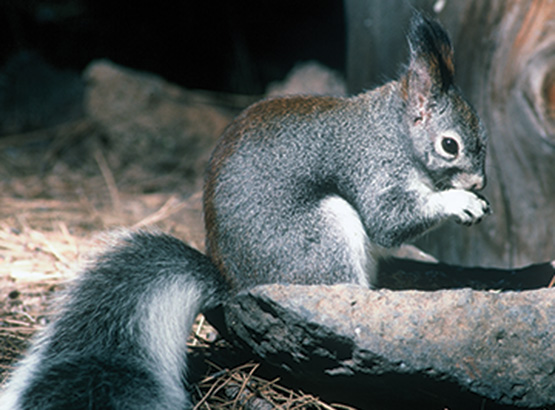Tree Squirrel
No fewer than four species and eight subspecies of tree squirrels can be found in Arizona’s forests. Of these, the Abert’s, a tassel-eared squirrel, is the most widespread and contributes most to the annual squirrel harvest.

About
Less well known than the Abert’s squirrel, is the Arizona gray squirrel and its close relative, the rust colored Chiricahua fox squirrel, both of which inhabit riparian deciduous forests and oak woodlands south of the Mogollon Rim. Another species is the chicaree, piney or red squirrel (actually more olive or gray than red in Arizona), which is restricted to the higher forests of spruce and fir above 8,500 feet elevation.
Tassel-eared (Abert’s) squirrels have but one breeding season a year, which is closely correlated with the production of the staminate flowers of ponderosa pine in late April, May, or early June. After a lengthy chase, the female comes into estrus for only one day. She will later give birth to a single litter of from two to four young in a nest made of pine boughs. Throughout the summer, the squirrels feed on the seeds of developing cones as well as on underground fungi or truffles that grow under mature pine trees. These foods are the most nutritious for the squirrel, and only when they are exhausted does the animal resort to feeding on the inner bark of pine twigs-the discarded terminals of which are often seen littering the forest floor.
Hunting & Trapping History
Tree squirrels have an uneven history as game in Arizona. Having gone from being totally ignored at the time of statehood, to having a limited season in conjunction with the deer and turkey seasons in the 1920s, the season was closed in 1935 due to a perceived lack of squirrels. Too many squirrels in the 1940s resulted in a re-opening of the season, and squirrel hunt regulations have since been liberalized gradually until every species and most subspecies are now subjected to limited hunting. Even the once sacrosanct Kaibab squirrel is now hunted, and the only totally protected squirrel is the federally endangered Graham Mountain spruce squirrel.
The Abert’s squirrel is the most hunted squirrel species and the numbers of tree squirrel hunters.

Our Mission
To conserve Arizona’s diverse wildlife resources and manage for safe, compatible outdoor recreation opportunities for current and future generations.
Hunt Regulations
Rules and regulations for hunting in Arizona.
Regulations for spring hunts, fall hunts and pronghorn, elk hunts.
